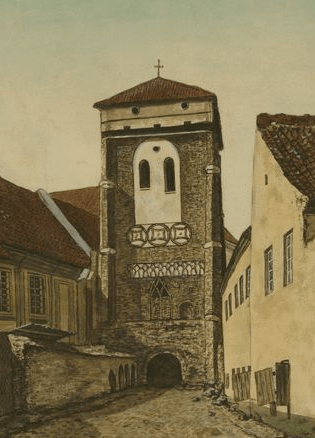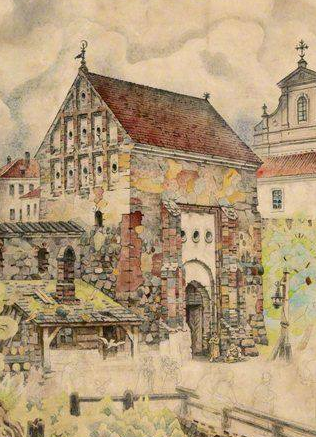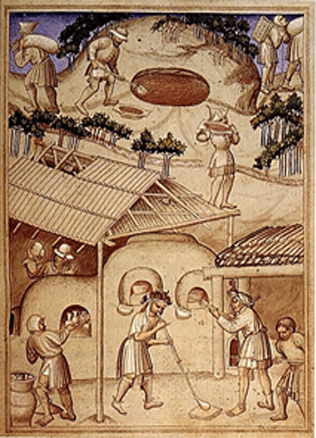Monuments Dedicated to the Victory of the Battle of Orsha in Vilnius
Do You Know?
The wars against Moscow launched in the late 15th century impoverished the Grand Duchy of Lithuania. From 1494 to 1514, one third of Lithuania’s territory was lost. On 30 July 1514, after a long siege, the fortress of Smolensk, regarded as a stronghold in North-eastern part of Lithuania, surrendered. Spurred on by this initial success, an almost 100,000 strong Muscovite army faced no further obstacles to invade the country.
An atmosphere of fear and insecurity was prevailing in the country. Sigismund the Old launched feverish attempts to mobilize troops in Lithuania and Poland.
Both countries, serving as the advance post of Christianity in the east, were making preparations to repel invaders from the East.
A joint army of about 30,000 warriors, mobilized during a relatively short time, under the command of the Great Hetman Orthodox prince Konstanty Ostrogski, headed towards Orsha, where the main Muscovite forces, numbering about 80,000 and led by Ivan Chelyadnin, had been deployed.
On 7 July, the joint troops headed by Ostrogski reached the Dnieper. On its other side threefold bigger Muscovite troops were positioned. The Great Hetman together with other military commanders discussed the battle plan.
Do You Know?
It is not certain whether he knew about the Lithuanian manoeuvre used by Vytautas the Great more than a hundred years ago, during the Battle of Grunwald. At that time, Lithuanian cavalry imitated a retreat from the battlefield, dispelling the ranks of Crusaders, then the troops were reorganized to return to battle and entered combat, finally gaining a victory. The battle plan discussed with military commanders on the Kropivna field near Orsha was a similar one. Lithuanian cavalry was to feign retreat from the battlefield and lure the main enemy forces chasing them into artillery ambush. The advance in artillery, achieved during a hundred years, was expected to determine the success of the battle. This was a risky plan, but in all likelihood, there was no other choice, considering the fact that the enemy forces were greater threefold.
Prayer as the most important military strategy
Do You Know?
Supraśl chronicle provides a description of Great Hetman’s behaviour, after the military camp was established. “Having reached the Dnieper near the town of Orsha and realized how difficult it would be to cross the river, this pious man and a military leader, well versed in the art of war, the venerable Great Hetman Konstanty Ivanovich hurried to the Blessed Trinity Church and prayed there to Almighty God and Saint Michael the Archangel.” A contemporary reader might regard such a haste to pray, shown by Ostrogski, as a hasty and formal ritual. It has to be understood, though, that a modern person regards success as a result of rational calculation or right decision, whereas in those days success was understood as the help sent by divine powers, be them God or the Saints.
Everyday life and every event was believed to be predestined in Heaven. Piety was permeating all spheres of life. Only prayer was believed to invite heavenly help, only thanks to prayer things happened the way they did. A personal will was not trusted, particularly in extreme situations (epidemics, wards, natural disasters).
The world was perceived as the battle of divine forces (God with angels and saints) against evil (Satan and his army).
The Battle of Orsha was to decide the fate of the Grand Duchy of Lithuania. The chance of winning against a far more numerous Muscovite army was slim. God’s miracle was believed to be the only help in such a situation. The help sent by Saints was also believed to assist in implementing the battle plan and gaining a victory.
If we could only share the feelings of helplessness, fear and uncertainty, fluttering round all those in anticipation of upcoming battle, we would understand that the Great Hetman’s prayer on the eve of the battle was far from formal.
A deal with God: (Orthodox) churches for a miracle
In the prayer, the Great Hetman of Lithuania begged God Almighty for mercy and help. To make sure that his prayer was heard, a deal had to be made with God.
He also entrusted his own fate and the fate of the army to the Lord’s care.
It reminded of a treaty between a suzerain and a vassal, in which the weaker party entrusted the stronger party with his care in order to get protection.
K. Ostrogski also addressed his prayers of intercession to St. Michael the Archangel, who was known to help those in need and suffering. The Saints were regarded as mediators between the heavenly and earthly worlds. The belief was prevailing that the Saints were always determined to help a human being and intercede for him before God. St. Michael is one of the most venerated saints by Orthodox Christians, regarded as a symbol of kindness and support, known to rescue the persecuted, the weak and those in dire need of help. Therefore, he is called a miracle-working Saint, and in ecclesiastic Slavonic texts he is referred to as Ugodnik – the one who helps.
Do You Know?
The Great Hetman strengthened the deal with God and St. Michael by taking a vow in front of military commanders. “And the above mentioned Konstantin, standing in the field of Kropivna, when a confrontation with the enemy was anticipated at any moment, in the presence of distinguished advisors and other military commanders made a pious and solemn vow to erect in our city of Vilnius two places of worship or chapels: one to honor the Blessed Trinity, and the other to honour St. Michael […] if the good and omnipotent God helps us achieve victory against the infidel enemy“.
The battle started on 8 September, early in the morning. Unexpectedly, the Lithuanian army crossed the Dnieper. During the battle, Lithuanian light cavalry seemed to waver, then feigned retreat. The main Muscovite troops started chasing them, were lured into an artillery trap and were wiped off the face of the earth by the artillery fire. Then Lithuanian and Polish cavalry entered combat. The Muscovite army started panicking and fled, chased by Lithuanians. 8 high Muscovite military commanders, 37 lower commanders, more than two thousand boyars and 5 thousand rank and file soldiers were taken captive. According to contemporaries, about 40,000 enemy soldiers were killed in the battlefield.
An Orthodox church in the centre of the capital: the Reward of a Catholic ruler for a miraculous victory
Great Hetman’s prayers were heard: the miracle worked. In the aftermath of the battle, thanksgiving prayers were offered in the military camp. At the beginning of December, a solemn welcome of K. Ostrogski was held in Vilnius.
Do You Know?
The ruler of Poland and Lithuania allowed K. Ostrogski to deliver on the pledge given to the Lord, by erecting in Vilnius two churches to honour St. Trinity and St. Michael. “We were taught by the Holy Scriptures and the Gospels to make vows to God and deliver them, […] therefore we allowed to build two brick churches – those of St. Trinity on the hill, along the road leading to Medininkai, where an old wooden Orthodox church bearing the same name and a monastery used to stand, and St. Michael’s, referred to as the Great, in the city centre. We allow to decorate them following the Orthodox rite.”
Like all the contemporaries, the ruler attributed the victory to God’s Providence: the victory achieved by the much smaller army of Poland-Lithuania (under 30,000 men) during the Battle of Orsha was regarded as a miracle, which was only possible thanks to Konstanty Ostrogski’s prayers and the pledge.
In gratitude to God Almighty and the Saint for intercession, two brick Orthodox churches – those of St. Trinity and St. Michael, were built in Vilnius. The churches served as a witness of the miracle for future generations and the remembrance of the Orsha victory. Rebuilt more than once, they have survived through all the hardships to the present day, to remind all of us of the omnipotence of God.
Remigijus Černius




